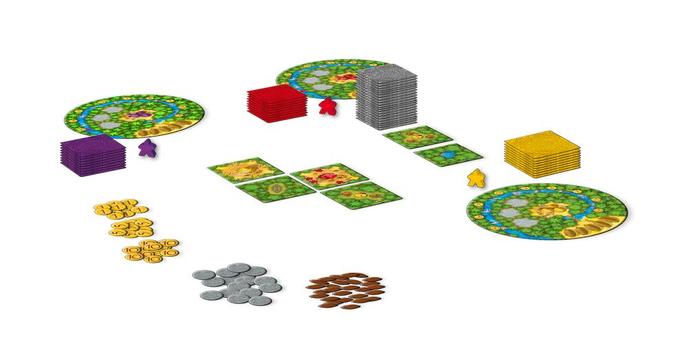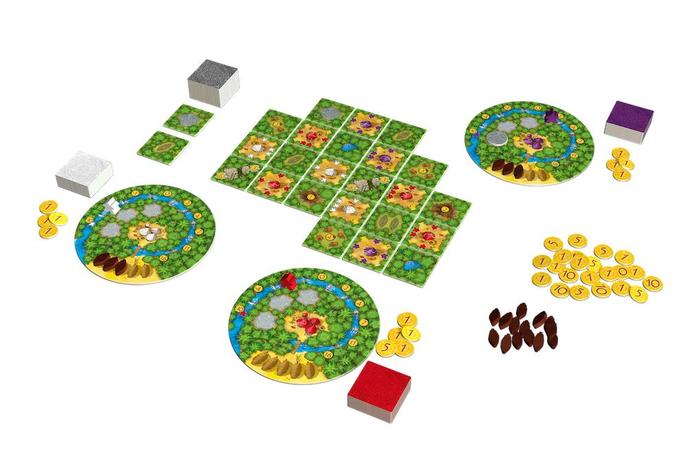
Cacao is a light-strategy tile-laying game that borrows a few visual elements from Carcassonne, giving the game a familiar feel, but has its own novel method of allowing players to gain points via placements of tiles from two different groups, which means the game presents something new while maintaining the interactive element that has made Carcassonne one of the greatest and most enduring titles of this current golden age of boardgaming.
In Cacao, players build the board as they go, taking on the role of explorer-traders working through the jungle to find cacao beans and sell them at various markets, while also looking for water sources, gaining control over temples, and discovering gold mines for more cash. The ultimate goal is to amass the most money, most of which comes through the sales of cacao, but with a significant swing coming from the water track on each individual player’s board, which begins at the -10 mark (meaning the player would lose ten points at game-end) and can move all the way to +16 if the player gets enough access to water during the game. So while the bulk of the points each player accumulates will come from selling cacao beans for two to four gold apiece, that water track can easily determine who wins the game.
Cacao comes with two different types of tiles—one set of common “jungle” tiles used by all players, and four sets of “worker” tiles for each player, differing only in the colors of the meeples printed on the edges of the tiles. Jungle tiles can show one or occasionally two cacao beans, a market with a price of two to four gold per bean sold, a water source, gold mines worth one or two coins per worker, sun worshippers, or temples. There are only three water tiles, just one market with a selling price of four, two sun worshipping tiles, and two tiles showing two cacao beans instead of one, making those tiles strategically important when they do appear, determined somewhat randomly by the shuffling of all jungle tiles at the start of the game.
Each player receives a set of worker tiles, eleven for a two-player game, ten for a three-player game, and nine for a four-player game. A worker tile shows four meeples along the edges, most either showing one meeple on every edge, or a 1-2-1 configuration with two meeples on one side and none on the opposite side; each set also contains two tiles with three meeples on one edge and one on the adjacent side, with those two tiles mirror images of each other. The action in the game comes when a player places a worker tile next to a jungle tile and has meeples on the connecting edge: Each worker (one to three, depending on the worker tile placed) gets to take the action shown on the adjacent jungle tile. For example, placing a worker tile’s one-meeple side next to a tile with one cacao bean on it nets the player one cacao bean from the supply. Placing one of the two tiles with three meeples on its side next to the four-gold market tile would allow the player to sell three cacao beans from his/her storage space for four gold apiece—the best play you can make when trying to sell.
Players begin the game by shuffling their worker tiles, then drawing a hand of three that they will replenish throughout the game. The board begins with a one-cacao bean tile and a two-gold market tile cater-cornered, after which each player places one worker tile adjacent to at least one jungle tile on the board. (Tiles of the same type may never touch along an edge, but only at a corner.) If the placement of a worker tile creates a space where a new jungle tile would border two existing worker tiles, then the player can choose one of the two jungle tiles laying face up next to the stack and place it however s/he wishes. Thus a proper turn would involve looking at the three worker tiles in your hand and the two jungle tiles available for placement and finding the best alignment of one worker tile and one or both jungle tiles—an alignment that helps you without helping your opponent(s).
Most of the game involves the acquisition and sale of cacao beans, which account for 15 of the game’s 28 jungle tiles. Water tiles are critical because they’re scarce and that water track scoring can account for a quarter or more of your points if you max out. The five temple tiles are worth points at the end of the game: six to the player with the most meeples on adjacent sides, three to the player with the second-most. The gold mine tiles aren’t all that valuable because there are higher-return uses for your meeples. The sun worshipper tiles allow players to accumulate up to three sun tokens over the course of the game, and you will almost certainly need at least two at game-end. The game ends when every player has placed all his/her worker tiles, but the jungle tile supply will run out first. Once that happens, you may spend one sun token to place a new worker tile on top of one of your own previously placed worker tiles—so, for example, if the game is ending and you have some beans left in storage (they’re worth nothing if unsold), you can drop a tile next to that four-gold market place and sell them for the highest price you can get in the game.
The strategic component is significant, but light, because little of the strategy involves thinking beyond the current move—if you’re cognizant of the lack of certain tiles on the board, like the water sources or the four-gold market, you might save your cacao beans or hold on to one of those three-meeple tiles, but it’s hardly necessary to do so to win the game. My nine-year-old daughter won a game by doing that and also maxing out her water track, and said she wanted to “let you guys think you were winning and then POW! do everything at the end.” It worked, as she racked up 68 points, the best mark we’ve had so far in three-player games, none of which has taken more than a half hour. It’s a fun family game in the rare intersection of two types—the game kids can understand and play well but that engages parents and keeps everyone competitive to the end.
Cacao was designed by Phil Walker-Harding and published by Z-Man Games.
Keith Law is a senior baseball writer for ESPN.com and an analyst on ESPN’s Baseball Tonight. You can read his baseball content at search.espn.go.com/keith-law and his personal blog the dish, covering games, literature, and more, at meadowparty.com/blog.

